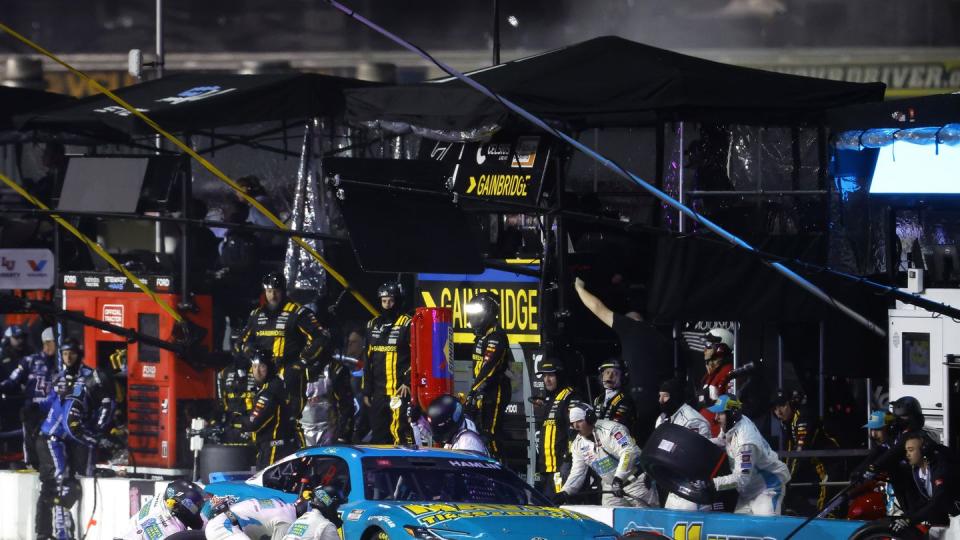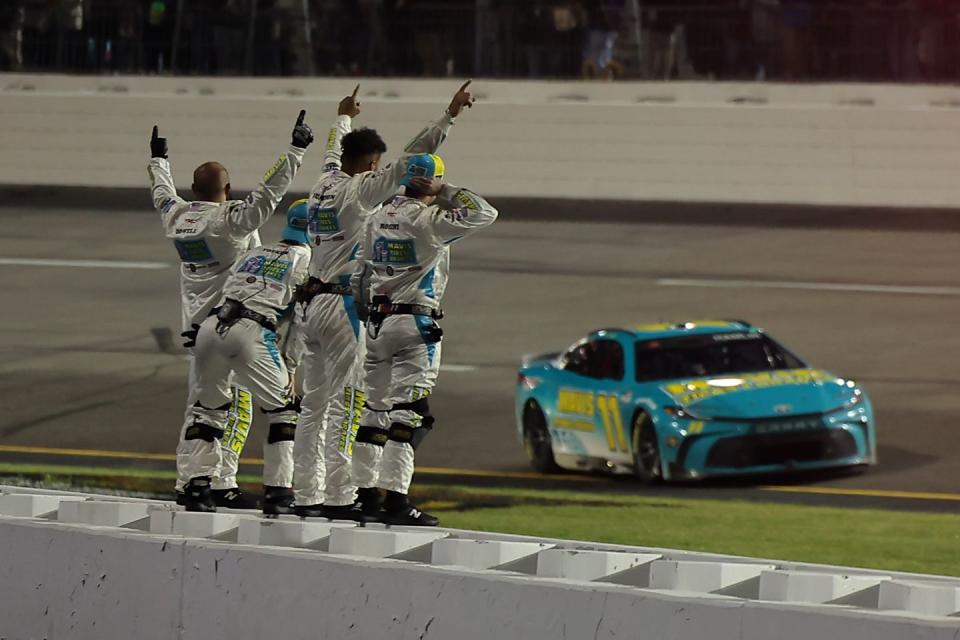How Suspension Design Won Denny Hamlin a NASCAR Race in the Pits

It looked like Denny Hamlin was set for a third place finish with two laps remaining in the Toyota Owners 400 NASCAR race at Richmond until a spinning car drew a caution flag and sent the race into overtime. Hamlin pitted for fresh tires and his crew was able to put him out front and leapfrog the frontrunners by over a second for that final restart. It all came down to a single tire on a single corner of the car.
Pit stops in the NASCAR Cup Series have become incredibly fast as they transitioned to single-lug wheels. It’s not unusual to see four tire changes in the single digit seconds now. The No. 11 Joe Gibbs Racing pit crew that works with Denny Hamlin has emerged as the dominant pit crew this season and all but one of their pit stops last night was down in those single digits. The unspoken variable here is that each race track commands a different suspension setup from the cars. That means tires come off and go on the car differently from week to week.
An optimal suspension configuration for Richmond Raceway will often lead to a left rear corner without a lot of droop. This means that when the car is jacked up in the air, the wheel will not drop very far down because everything is configured so tightly. This can result in the tire being very close to the lip of the fender and means that tire changers and carriers have to be very precise on the exchange.

The left rear tire is what ultimately appears to have made the difference on that final pit stop which saw Denny Hamlin and Martin Truex Jr. swap position on pit lane with Hamlin taking the lead for that final restart. Hamlin’s crew was able to execute another successful pit stop, which showed that they changed four tires in 8.99 seconds while the No. 19 crew for Martin Truex Jr. was over a second behind with a time of 10.29 seconds for their four tire change.
Let's watch that pit stop.
The pit stop that cost @MartinTruex_Jr the race, his crew seemed a little slow on the rear end. #ToyotaOwners400 #NASCAR pic.twitter.com/bLBnCOk5rg
— Peter Stratta (@peterstratta) April 1, 2024
We can see the No. 19 pit crew moving quickly on the right side of the car in the video above. As they make their way to the left side, we can see a delay on the left rear. This is where that limited droop comes into play and makes that left rear tire harder to pull. That delay quickly compounds itself -- the jack handler is late installing that tire, which results in the front tire changer turning to lower the jack instead of the jack handler, which deviates from the crew's standard pit stop process.
The overall delay is almost hard to catch in the video because it seems pretty insignificant. The car leaves fairly quickly, but the margins in the NASCAR Cup Series are so small now that every tenth matters. The pit crew of the No. 23 of Bubba Wallace showed one of the worst-case scenarios of this situation. They had similar delays on the left rear, but the issues compounded even worse as the front changer dropped the jack before the rear changer was done fastening that rear tire. They had to jack it back up to finish tightening it which resulted in a pit stop of almost 13 seconds.

This is an interesting thematic intersection of pit stops and suspension design, race strategy from an engineering standpoint and race strategy from a pit crew standpoint. TO get a sense of it, we need to understand how NASCAR regulates suspension, and how teams adjust it.
NASCAR Cup cars employ an independent rear suspension that is tightly controlled by NASCAR. Where teams do have options is on how they can set their dampers, along with choices of springs. Teams will use that adjustability to adapt the balance of the car for specific tracks. In addition to how they set up the car prior to a race, the rear dampers also have weight jackers on them. These can be adjusted during a race itself by a pit crew member reaching through the rear window with an adjustment wrench. The rear anti-roll bars also have adjustable blades that can be turned in order to shift the balance of the car.

As last night’s race started in damp conditions on wet weather tires, it meant that teams had to make adjustments on their car as the track dried out and they switched to slicks. This can result in things like the position of that rear wheel changing slightly as adjustments are made and crew members having to adapt in how they pull the wheel off and install the new one. Crew members being able to adapt quickly to changing conditions like that is what can make the difference on giving your driver the best opportunity to come out first on pit lane. In the case of the pit stops last night, the No. 19 crew had a hiccup there on that left rear because the suspension was so tight to the car while the No. 11 crew was able to adapt just a bit better and move faster in that corner to gain that second over the No. 19 crew and send Hamlin out first.

Certain tracks can also have the opposite effect on droop and the tire can fall too low from the car as it is jacked up. In those cases, NASCAR actually allows teams to add a tether to the suspension to hold the tire up at a certain height for those pit stops, as seen in the illustration above. Most pit crews will do a walkthrough with their engineers or crew chief at the shop before a race weekend and measure exactly how far each tire drops so they can have a reference point for the race. They will often follow up on race day morning with additional measurements in case things change due to adjustments at the track.
While NASCAR pit stops may seem like a lot of speed and brute force, sometimes it all comes down to the small details. The position of a rear damper or spring can easily impact whether a tire is removed or installed quickly enough to lead to a race win.
You Might Also Like

 Yahoo Sports
Yahoo Sports 
